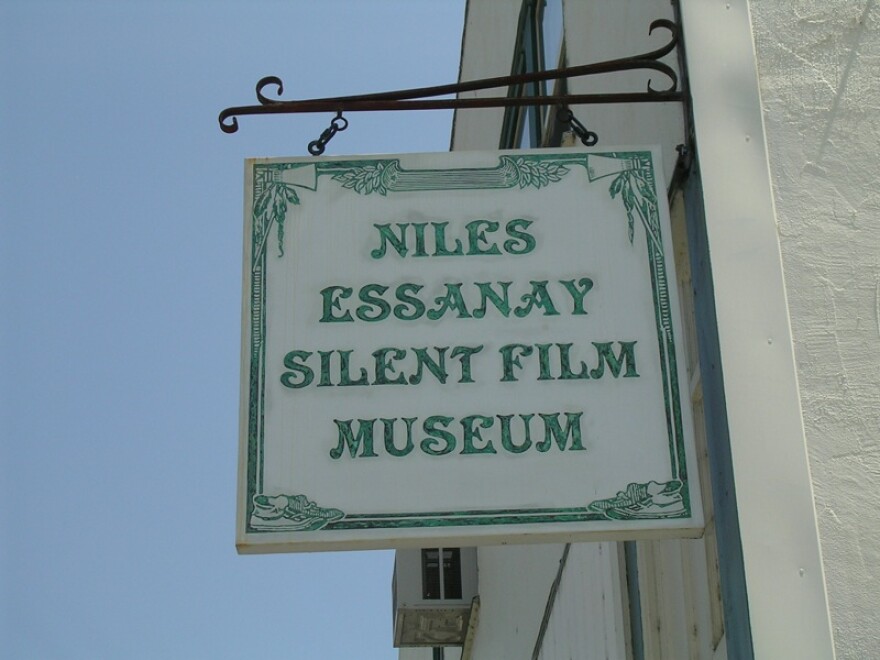“Good Evening and welcome to the Niles Essanay Silent Film Museum and to the Edison Theater,” says Tommy Andrew to a bustling crowd. Andrew is the host of the weekly silent film screening in Niles. He stands in front of the screen and explains that the museum only exists because of New York actor Max Aronson. Aronson, who renamed himself Gilbert Anderson, got his big break in films at the turn of the last century after he lying about his ability to ride a horse. He got a small part in what became a very popular film called The Great Train Robbery. In 1912, Anderson and his partner, George Spoor, came to California from Chicago. They named their company S & A, for Spoor and Anderson.
“Gilbert Anderson was in the very first western that was ever produced,” explains Andrew. “It was such a fantastic hit, he thought, ‘This is the genre to get into.’”
Based on the success, Anderson wanted to find an authentic western location to shoot his films. After scouting all over the country, he discovered Niles Canyon. Niles was a great location for westerns films. It had a train that ran through a nearby canyon, a small town with several saloons, and the availability of real cowboys from the surrounding area who were no longer finding employment in cattle drives and ranching. They were happy to be paid $4 to $5 a day to ride horses and shoot guns for S & A films. Bronco Billy Anderson went on to make over 350 in Niles in just over four years.
“And also he discovered a talented individual that was a comedian, that was showing a lot of promise by the name of Charlie Chaplin,” continues Andrew.
Niles had a big impact on Charlie Chaplin’s career, says film historian David Kiehn. Kiehn is also the author of the book Bronco Billy and the S & A Film Company, as well as the Niles S & A Silent Film Museum projectionist. “Charlie Chaplin’s career really blossomed after joining S & A,” says Kiehn. “He made 34 films at the Keystone company the year before and they were typical Keystone knockabout comedies. You could see there was a spark of genius in Chaplin, but he was kind of an unlikeable character in his Keystone films.”
But at Niles, he fell in love with Edna Purviance and Kiehn says that love transformed him into the kinder, gentler Chaplin that would achieve worldwide fame.
During each week in Niles, the S & A film company produced two to five 15-minute one-reelers. The filmmakers shot them in San Francisco using locations like Golden Gate Park, but they filmed mainly in and around the Niles studios, which had been built by S & A in 1913. When Chaplin’s contract came up for renewal at the end of 1915, S & A wouldn’t agree to his salary demands. Chaplin moved on to Los Angeles and the Niles film production center folded barely three months later. But these Bay Area based films live on thanks to the Niles Silent Film Museum, which screens them every Saturday night.
Chuck Ringem Newark comes twice a month. “It’s funny,” says Ringem. “I had no idea how much I enjoyed sitting here watching a movie, without no sound. Totally different. I love it.”
Alex Alamano of San Leandro attends the films with his father and sometimes his little brother. Alamano says his favorite silent film actor is Buster Keaton because “he’s like the martial arts gu y… doing lots of tricks. Even my brother likes him.”
Those who present the silent films in Niles get to share their passion for them and their skills with the audience. As pianist Judy Rosenberg watches the film, she plays piano, improvising on a musical theme she has already written. The music is part of what makes the experience special to Emcee Tommy Andrew. “I love the live piano,” says Andrew. “It’s the combination, the live music and the cinema, that’s just thrilling to me.”
In a sense, coming to this museum is like stepping into a time machine that takes the audience back to Niles during the years 1913 to 1923. On any Saturday night, you can come to the Niles Edison Nickelodeon Theater and see silent films with live music, just like the audiences of that era.


